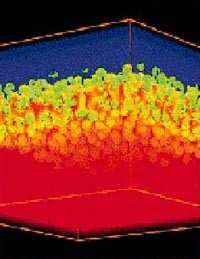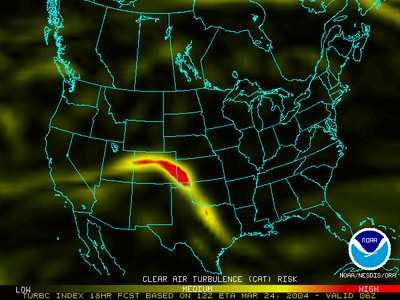Langley Comes Up With Turbulence Reporting System
 Most airline passengers and flight
crews have one thing in common: they don't like turbulence.
Researchers at NASA's Langley Research Center in Hampton, VA, and
AeroTech Research (USA), Newport News, VA, have developed an
automatic turbulence reporting system.
Most airline passengers and flight
crews have one thing in common: they don't like turbulence.
Researchers at NASA's Langley Research Center in Hampton, VA, and
AeroTech Research (USA), Newport News, VA, have developed an
automatic turbulence reporting system.
The Turbulence Auto-PIREP System (TAPS) is being tested on more
than 80 Delta Airlines passenger jets. Researchers say TAPS
technology improves aviation safety. When pilots know there's
turbulence ahead, they can maneuver to avoid it or ensure
passengers and flight attendants are seated and strapped in.
"TAPS automatically broadcasts turbulence encounter reports from
aircraft and allows other planes and people on the ground to use
this information," said NASA's Turbulence Prediction and Warning
Systems project manager, Jim Watson. "Pilots describe turbulence
encounters over their radios and by text reports called Pilot
Reports (PIREPS). They tend to under-report when they encounter
rough air, because they're busy trying to fly through or around
it," he added.
"TAPS provides real-time turbulence information that has never
been available," said Paul Robinson, President of AeroTech
Research. "The beauty of TAPS is, it is only software and uses
equipment already on the aircraft, making it inexpensive and easy
to install."
 Atmospheric turbulence is the
leading cause of injuries to passengers and flight crews in
non-fatal airline accidents. Federal Aviation Administration (FAA)
statistics show an average of 58 airline passengers are annually
hurt in U.S. turbulence incidents. Ninety eight percent of those
injuries happen because people don't have their seat belts
fastened.
Atmospheric turbulence is the
leading cause of injuries to passengers and flight crews in
non-fatal airline accidents. Federal Aviation Administration (FAA)
statistics show an average of 58 airline passengers are annually
hurt in U.S. turbulence incidents. Ninety eight percent of those
injuries happen because people don't have their seat belts
fastened.
Turbulence encounters are hazardous, and they cost airlines
money and time. The encounters cause injuries, flight re-routing,
late arrivals, additional inspections and aircraft maintenance.
Delta Air Lines and ARINC, Annapolis, Md., have teamed with NASA
and AeroTech Research to evaluate TAPS. Since August 2004, the TAPS
software has been flying on more than 85 Delta Boeing 737-800,
767-300 and 767-400 aircraft.
TAPS' automatic, accurate and timely reporting of turbulence
encounters is almost immediately displayed on computers on the
ground and received in the cockpits of other aircraft. The system's
processing of encounters takes into account how various aircraft
respond to turbulence. TAPS allows pilots to see the reports for
the area ahead of their aircraft; controllers to see reports
relative to air traffic and airline personnel to evaluate the
impact on their operations; all in real-time.

"From an airline standpoint, we see tremendous benefit from TAPS
in identifying areas of turbulence," said Bill Watts, the
turbulence program manager for Delta Air Lines. "In addition to its
obvious safety benefits, the system may potentially identify areas
of airspace that would otherwise be blocked from traffic because of
the inadequate turbulence detection tools that we possess today.
TAPS gives us some much needed hard data that can help us make
better operational decisions."
The turbulence research was funded by the NASA Aeronautics
Research Mission Directorate's Aviation Safety and Security Program
in partnership with the FAA, aircraft manufacturers, airlines and
the Department of Homeland Security.
 ANN's Daily Aero-Linx (04.16.24)
ANN's Daily Aero-Linx (04.16.24) Aero-News: Quote of the Day (04.16.24)
Aero-News: Quote of the Day (04.16.24) Airborne 04.10.24: SnF24!, A50 Heritage Reveal, HeliCycle!, Montaer MC-01
Airborne 04.10.24: SnF24!, A50 Heritage Reveal, HeliCycle!, Montaer MC-01 Airborne 04.12.24: SnF24!, G100UL Is Here, Holy Micro, Plane Tags
Airborne 04.12.24: SnF24!, G100UL Is Here, Holy Micro, Plane Tags Airborne-Flight Training 04.17.24: Feds Need Controllers, Spirit Delay, Redbird
Airborne-Flight Training 04.17.24: Feds Need Controllers, Spirit Delay, Redbird





